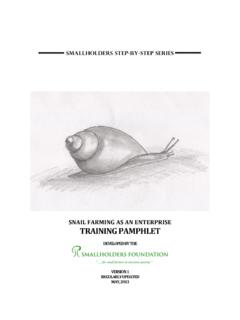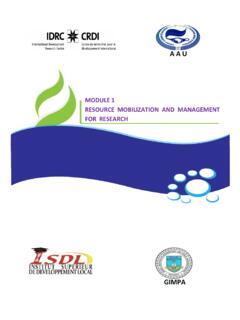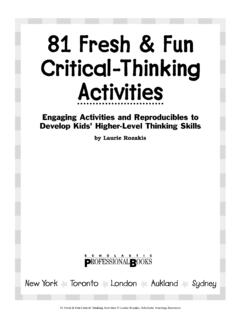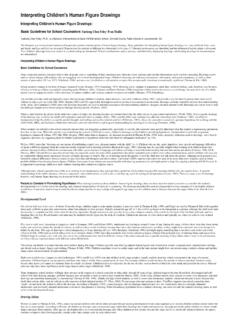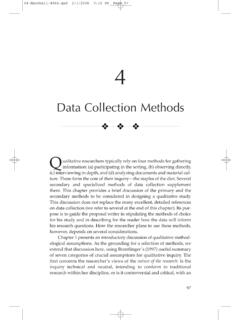Transcription of Art activities for abused children - VIDEA
1 1 Integrating Art and Play Based activities into children Who witness Abuse Programs Provincial Training conference March 3 & 4, 2012 Play is the exultation of the possible. Martin Buber 2 3 Table of Contents Acknowledgements Introduction Raffi s Principles for Child Honouring Information Highlights CWWA Mandate Key Program Goals Non Directive, Child Centered Approach The Unique Needs of CWWA Client Population How children are impacted by Witnessing Abuse Art-as-Therapy vs. Art Therapy Benefits of Art and Play in CWWA Programs Helping Kids Manage Anger Art and Play Based activities that Complement the CWWA Mandate CWWA Counselling Thematic activities to Complement CWWA Group Framework Art activities Personal Shield Mandala Paper Bag Puppet Two-sided Paper Plate Feelings Mask My Family as Animals Moodscape Additional Art activities Relevant Toys for CWWA Program and Play activities 4 Introduction to Art Materials Asking Questions about Artwork or Play Basic Guidelines for using Art and Play Based activities in CWWA Program Ideas for Working Creatively with Teens Repurposed and Natural Materials Creating a Child Friendly Space Axline s Tenets for Relating to children Objectives of Child-Centered Play therapy
2 Six types of Play Common Themes in children s Play Sand tray Figures Final Points to Consider Special Presentations Tatjana Jansen Grief and Loss Trauma Developmental Ages and possible Reactions to Loss Exercise: Loss/ Change History Building Resilience Conditions for Creative Growth Issues that Impact Art Strategies for Containment 5 Exercise: Squiggles and Scribbles Exercise: Non-Verbal Communications Drawing Shannon Guiboche PowerPoint Presentation: What Now? Before, During and After a Disclosure Grounding Ideas Templates Links and Other Resources 6 How you regard and treat the very young is the key to building humane and sustainable cultures. It s all about respect. Raffi on his philosophy of Child Honouring 7 (Insert Raffi s Child Honouring Principles pdf) 8 Acknowledgements This provincial training initiative for children Who Witness Abuse Programs would not have been possible without the dedication, support, expertise, and generosity of many individuals and organizations.
3 We would like to offer our heartfelt thanks to those who made it all possible: Ministry of Public Safety and Solicitor General, for funding this project Michele Matthews and Brittney Gaglardi for their generous provision of quality art supplies and funding for other necessary materials Shannon Guiboche, VISAC Victim Services Support Worker with the Vancouver Police Department Sex Crimes Unit, for offering her time and expertise Gina Fernandez, photographer, for her time and contributions Kerstin Mansson, practicum student from the University of Lund, Sweden for all of her invaluable assistance during the conference Through this support, the workshop went ahead and proved to be a great success. This book provides highlights, key learning, and shared ideas from the two-day workshop, and clear evidence on how art, play, and creativity can complement CWWA goals and mandate.
4 Many participants commented on how they left with renewed spirit and ideas for their work. And so, we d like to extend a warm thank-you to everyone who made this possible, including all of the dedicated and enthusiastic CWWA counselllors who attended. We hope you will continue to support and inspire one another through the sharing of your professional experience at conferences such as this one! 9 Introduction In early March 2012, 50 participants from all around British Columbia came to this dynamic, interactive workshop to learn more about art and play activities , and how they complement the CWWA program work that is already being done in their communities. During the two-day conference, we covered many topics: some foundational guidelines to help inform the inclusion of art and play with program goals, trying out various art materials, engaging in hands on art activities , and learning about types of activities that complement the psycho educational objectives of the program.
5 Highlights of these materials are included in this supplementary book. On the second day of our workshop, we were fortunate to have presentations from three special guests: Shannon Guiboche, VISAC Victim Services Support Worker with the VPD Sex Crimes Unit, and Registered Clinical Counsellor-Art Therapists Tatjana Jansen, and Kali Dukowski. Together, they covered some of the more difficult topics, such as disclosures, grief and loss, trauma and sexual reactivity. Due to their generosity, we have been able to include additional supplementary materials, plus a little more. We are very pleased to compile and share this collection of material that supports not only what was learned and explored during the workshop, but that will also enhance the ongoing professional development of CWWA counsellors, and provide further ways to support the children they work with.
6 Thank you! Rhonda Gaidica and Joanne Elliott 10 CWWA Mandate CWWA Program: Strengths based, child-centered, psycho-educational Feminist perspective Acknowledges developmental factors Approach: Psycho-educational, Feminist, developmental While the overall approach is psycho-educational, individual counsellors have a wide range of backgrounds and are encouraged to draw on their own specific skills while recognizing the limits both of their training and of the program mandate. Some CWWA counsellors, for example, use techniques associated with art and play therapy to meet the needs of the children with whom they work (p. 4-5). Purpose of psycho educational approach: To provide bite-sized pieces of information to children To teach children strategies for safety and managing feelings Training (CWWA counsellors) Acknowledges varied range of backgrounds and experience Boundaries and Scope of Practice- know your own limitations, as well as where to turn for additional assistance, if needed.
7 11 Key Program Goals: Define violence and responsibility for violence Express feelings, including anger Improve communication, problem-solving, and cognitive coping skills Increase self-esteem Develop social support networks Develop safety plans Experience safety and trust during group sessions 12 Non Directive, Child- Centered Approach Self-directed healing and decision-making empowers children by giving them choices Less likely to push child beyond their readiness and capacity to deal with trauma Child learns to self-regulate emotions Allows Counsellor and child to stay in the present Encourages/permits reality-testing, exploration, imagination/creative problem-solving; promotes resilience Directed and Non-Directed Approaches Longer term counseling lends itself to a non-directive, spontaneous approach in which you follow the child s lead.
8 Directed, more structured or themed activities can be useful in conjunction with shorter term counselling or groups. Directive and Non-directive activities Directive (structured) A predetermined activity, predetermined goal; can be helpful when focusing on specific issues/themes, or getting unstuck ; Complements CWWA group work. Externally directed. Examples - Family portrait as animals, A Perfect Day, games Non-directive (unstructured) Spontaneous activities , following the child s lead; self-generated imagery (from within, dreams, or imagination) No right or wrong way to do this and no expected result. Internally directed. Example Child chooses particular activity or media (play or art) 13 The Unique Needs of CWWA Client Population children who have witnessed or experienced abuse can benefit from use of art and play in conjunction with the existing psycho-educational framework.
9 These unique needs are: A sense of safety, trust, nurturing, and a familiar, consistent, structured and comfortable environment. Permission to play, have fun and to be just kids, since they have likely been parentified. Similarly, there may be developmental gaps in the artwork or play due to missed stages while contending with abuse. 14 How children are Impacted by Witnessing Abuse Fearfulness, anxiety, clinginess Aggression, acting out (externalizing feelings) Poor self esteem, depression (internalizing feelings) Regression to earlier developmental stage (temporary) bed-wetting, thumb-sucking PTSD; hyper-vigilance Nightmares, sleep disturbances Emotional numbing, dissociation, spacing out Trust and boundary issues Feelings of anger, shame, helplessness, anxiety, confusion, guilt, sadness 15 What are Art and Play Therapy?
10 Art therapy combines the creative process and psychotherapy, facilitating growth through self-exploration and understanding. Using imagery, colour, and shape as part of this creative therapeutic process, thoughts and feelings may be expressed that would otherwise be difficult to articulate. Play therapy involves using play materials to meet the emotional, social, psychological, and developmental needs of children . It is generally employed with children aged 3 through 11 and provides a way for them to communicate their experiences and feelings naturally, through a self-determined healing process. Play therapy is to children what counseling is to adults. Play therapy utilizes play, children 's natural medium of expression, to help them express their feelings more easily through toys instead of words.

